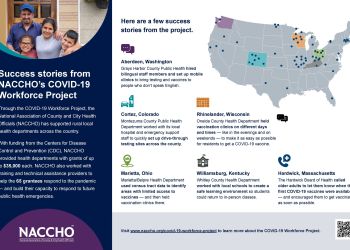The COVID-19 pandemic has changed almost every aspect of how we work, learn, and connect. Drastic change has forced many of us to try new strategies, and suffer through uncomfortable glitches and transitions. However, as a society, we have adapted with remarkable speed and flexibility. Many of the rapid innovations and solutions that became widely available during this time are accommodations that people with disabilities have advocated for decades, including remote working and tele-health appointments. This overnight acceptance of remote working and learning is bittersweet for many in the disability community, underscoring that employer and institutional indifference and rigidity was more to blame for not providing these accommodations than insurmountable technological or system barriers. There is growing evidence that working and collaborating virtually can yield benefits for everyone, so this could be an important turning point that extends new opportunities to many, including the disability community.
As we progress through different phases of physical distancing, it seems likely that virtual meetings and conferences are here to stay. This may have specific implications for local health departments, as so much of your work is grounded in principles of community outreach and engagement. Below are a few simple strategies for making virtual gatherings convenient and welcoming for diverse stakeholders, including participants with disabilities.
Before the Meeting
- Practice and prepare a meeting strategy. Do a practice run with the meeting platform, and designate at least two hosts for meetings. This way, one person can focus on engaging participants, and keeping the meeting on track, while the other handles the technology, such as forwarding slides, or keeping an eye on the meeting cue/waiting room to let participants join. For larger meetings, it may be helpful to designate an additional person to monitor participants’ written comments, and to help infuse questions and feedback into the dialogue.
- Provide a combination of high-tech and low-tech options. This is a useful document to help your team consider and respond to the digital divide. Participants’ access and familiarity with technology will vary broadly, and it is important to offer a range of meeting options. Most meeting platforms offer a dial-in number; so be sure to list this information in all meeting announcements to include those without computer access, or for those who may simply prefer using their phones without the extra step of installing the platform application.
- Consider your purpose and goals before convening a meeting. As this article describes, there are easy ways to make meetings more productive, including thinking carefully about whether you need to meet, and who should be invited to attend meetings. Finally, this blog offers some concise, but important, tips on good virtual meeting etiquette.
- Consult diverse groups to create a solid meeting strategy. People with disabilities have unique expertise negotiating barriers, and their insights could be particularly valuable during a time when society is facing new obstacles to “life as usual.” For example, Rooted in Rights offers a comprehensive list of suggestions for accessible and inclusive virtual meetings, including advice from disability advocates and leaders.
- The inclusive Virtual Community Engagement during COVID-19 page offers helpful guidance for planning and conducting authentic and equitable virtual community engagement initiatives. Also, view this anti-oppressive facilitation document for more tips on how to gather input, and create opportunities for sharing ideas.
During the Meeting
- Set the tone and layout a plan. The meeting facilitator is key to making the meeting space feel comfortable, and for describing how participants can engage. It may be helpful to begin each meeting with a quick overview of meeting features (for instance, let participants know how to mute, unmute, and ‘raise their hands’). Explain if there will be a designated time for questions, or if people are encouraged to use the chat box to interact. Keep in mind that the chat platform could be challenging for attendees with attention deficit disorders, inconvenient for participants using a switch device, and disruptive for people using screen readers, because the chat dialogue is a layer of sound over the presenter. This helpful blog offers good suggestions, including thinking of the chat along the same lines you would consider audience members conversing with each other in the middle of an in-person meeting.
- Provide a variety of options. Do not assume everyone feels comfortable turning on their video feature. Make this an option, not a requirement, in virtual meetings. While some people are comfortable speaking up in large groups, others may feel daunted. For larger meetings, intersperse opportunities to encourage interaction among your participants, using smaller breakout sessions, or through one-on-one sharing. On the Zoom platform, there is a breakout room feature to allow smaller group discussions.
- Consider accessibility— Design for different learning and processing styles. Practice describing visual images and graphs as you would if nobody had access to your slides. This way, your explanations will support the visual presentation, without overly relying on photos or charts to make a point. Sending out the agenda and slides ahead of the meeting can make sure all participants get to review materials at their own pace, and use technology that works best for them.
- Consider experimenting with different tools, like Mural, to mimic a brainstorming session with “idea boards” and “sticky notes.” Watching discussions unfold in real-time will be helpful for some participants. Additionally, many meetings use a quick poll to help shape discussions. Remember to verbalize what people are sharing for those who cannot view the exercise, and offer alternate methods so that who cannot access the poll can weigh in.
- If your content is public facing, consider language interpretation, and closed captioning services. This resource from the Deaf/Hard of Hearing Technology Rehabilitation Engineering Research Center includes advice for meeting the needs of people who primarily use sign language during virtual meetings.
- Create connections among participants. In the absence of office chitchat, it helps to infuse meetings with congenial human elements. Using warm-ups, ice breakers, and check-in questions can invigorate, and launch creativity to frame a meeting. The Center for Story-based Strategy has compiled a list of fun prompts to provide a bit of levity, and get meetings off to a good start.
After the Meeting
- Do not forget to build on the meeting or conference with proper communication and follow-up. Send out accessible meeting slides, and captions/transcripts. Collect feedback on what worked well for participants, and what may have made the meeting better.
- Be flexible. Technology will inevitably have hiccups. Aim for comfortable, equitable, and easy participation, and be kind to yourself and your team as you learn together.






